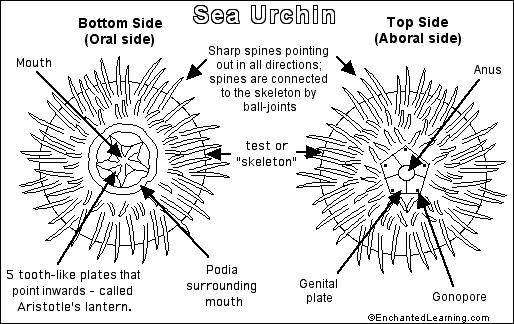
 |
| You might also like: | Sea Cucumber Printout | Echinoderm Printouts | Sea Anemone Printout | Sand Dollar Printout | Brittle Star | Today's featured page: Library Scavenger Hunts |
| Echinoderm Printouts | EnchantedLearning.com Sea Urchin | Animal Printouts Label Me! Printouts |


Adult Anatomy: Adult sea urchins have five-sided radial symmetry. Their skin has hard, chalky plates, and is called the test. Sea urchins have a globular body and long spines that radiate from the body. The spines are used for protection, for moving, and for trapping drifting algae to eat. Among the spines are five paired rows of tiny tube feet with suckers that help with locomotion, capturing food, and holding onto the seafloor. Tiny pedicellarines are small stinging structures that are used for defense and for obtaining food. Like all echinoderms, sea urchins do not have a brain. The mouth is claw-like and is located on the underside; it has 5 tooth-like plates that point inwards and are called Aristotle's lantern. The anus and the genital pores are on the top of the sea urchin.
Diet: Sea urchins eat plant and animal matter, including kelp, decaying matter, algae, dead fish, sponges, mussels, and barnacles.
Predators of Sea Urchins: Sea urchins are eaten by crabs, sunflower stars, snails, sea otters, some birds, fish (including wolf eels), and people.
Reproduction: Fertilization is external. Female Sea Urchins release several million tiny, jelly-coated eggs at a time. Eggs or sperm are released through five gonopores. As they develop, the tiny larvae (called the pluteus, which have bi-lateral symmetry) swim in the sea and are a component of zooplankton. It takes several months for juvenile sea urchins to form. The time from fertilization to a reproductive adult is from 2 to 5 years.
Classification: Kingdom Animalia (animals), Phylum Echinodermata (echinoderms), Class Echinoidea (Sea Urchins).
| Search the Enchanted Learning website for: |